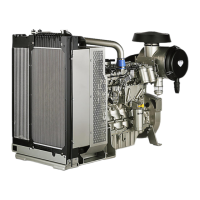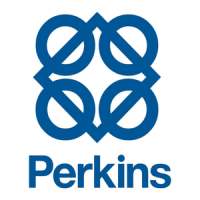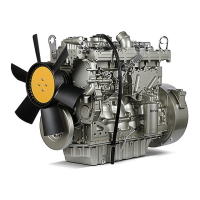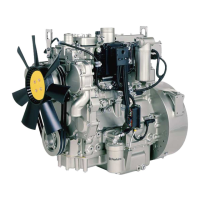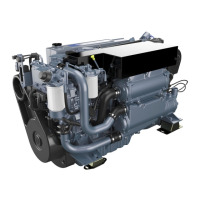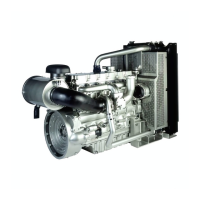Do you have a question about the Perkins 1106A-70TA and is the answer not in the manual?
Information about the manual's content, storage, language, and compatibility.
Lists basic safety precautions and identifies hazardous situations.
Outlines basic operating techniques and procedures for inspection, starting, and stopping.
Guide to engine care with step-by-step instructions by service hours/calendar time.
Details recommended service intervals and how to adjust them.
Information on major engine overhaul procedures and authorized personnel.
Warning about diesel exhaust, lead compounds, and reproductive harm.
Discusses warning signs on the engine, their location, and maintenance.
Covers hazards identified by safety alert symbols, signal words, and pressure air/water use.
Hazards related to hot components, coolant, oils, and batteries.
Discusses flammability of fluids and prevention measures.
Advice on safe handling of rotating/moving parts and debris.
Guidance on mounting and dismounting the engine safely.
Pre-start checks and precautions for safe engine operation.
Procedures and warnings for starting the engine safely.
Procedures for safely stopping the engine and emergency stops.
Safety precautions for the electrical system and battery connections.
Discusses tampering risks, monitoring systems, and parameters.
Overview of typical engine features and application variations.
Shows typical engine features and component identification.
Lists the characteristics of the 1106 series industrial engines.
Defines front/left/right sides of the engine and cylinder numbering.
Shows typical locations of serial number and emissions certification plates.
Procedures for safely lifting and storing the engine.
Explains shutoff and alarm systems, their settings, and testing.
Describes how to interpret engine gauges and indicators for performance.
Details monitored parameters like coolant temp, oil pressure, and speed.
Information on detecting and managing engine overspeed conditions.
Shows typical locations of switches and electronic components.
Outlines daily and periodic maintenance before starting the engine.
Safety warning regarding starting aids in cold weather.
Step-by-step procedure for starting the engine safely.
Safety warning about using jump start cables.
Procedures for checking systems and gauges after engine start.
Tips for optimizing fuel economy and engine performance.
Advice on starting and operating the engine in cold weather.
Importance of oil viscosity for engine cranking and performance.
Advice on coolant protection for low temperatures and mixture.
Function and types of engine block heaters for starting.
Procedures for idling the engine in cold weather for warm-up.
Procedures to warm up an engine that has cooled below normal temperatures.
Explanation of the water temperature regulator and its function.
How fuel properties affect cold weather performance and filters.
Information on OEM-equipped fuel heaters and temperature limits.
Procedures for shutting down the engine and cool-down period.
Use and procedures for emergency shutoff controls.
Lists approximate capacities for engine crankcase oil and cooling system.
General information about coolant, including contamination and maintenance.
Information on fuel quality, diesel fuel requirements, and glossary.
Details on diesel fuel properties like cetane, viscosity, and density.
Information on biodiesel fuel types, blends, and specifications.
Information on lubricant recommendations, EMA, and API oil classifications.
Safe welding procedures to avoid damage to electronic components.
Identifies conditions that exceed standards and may require adjustments.
Lists scheduled maintenance tasks by service hours or time intervals.
Procedures for inspecting, cleaning, and testing the aftercooler core.
Scheduled inspection of the alternator for connections and charging.
Procedures for replacing the engine battery safely.
How to check and maintain battery electrolyte levels.
Steps for safely disconnecting battery cables.
How to inspect, adjust, and replace engine drive belts.
Procedure for changing commercial heavy-duty coolant.
Procedure for changing Extended Life Coolant (ELC).
How to check coolant levels in systems with or without recovery tanks.
Procedures for testing and adding SCA to the cooling system.
Guidance on checking driven equipment as recommended by the OEM.
Importance and procedures for cleaning the engine to prevent fire hazards.
Procedures for inspecting, cleaning, and replacing dual element air cleaners.
Procedures for single element air cleaner inspection, cleaning, replacement.
How to inspect and test the air cleaner service indicator.
Procedures for checking and cleaning the air precleaner.
Procedure for replacing the engine crankcase breather.
How to inspect engine mounts for deterioration and proper torque.
Procedure for checking the engine oil level.
How to obtain engine oil samples for analysis.
Procedures for changing engine oil and filter.
Procedure for checking and adjusting engine valve lash clearance.
How to check fan clearance in the cooling system.
Procedures for purging air from the fuel system.
Steps for replacing the primary fuel filter and water separator.
Procedures for draining water and sediment from fuel tanks.
Procedure for replacing the secondary fuel filter.
How to inspect and replace fuel and coolant hoses and clamps.
Procedures for cleaning the radiator fins and core.
Scheduled inspection of the starting motor for operation.
Visual inspection of the turbocharger for damage and leaks.
Quick checks before starting the engine for leaks and loose items.
How to inspect the water pump for leaks and potential overheating issues.
General warranty information for the engine.
Information on emissions certification and warranty coverage.
Information on available reference materials and resources.
Details on Extended Service Contracts for engine protection.
Information about the manual's content, storage, language, and compatibility.
Lists basic safety precautions and identifies hazardous situations.
Outlines basic operating techniques and procedures for inspection, starting, and stopping.
Guide to engine care with step-by-step instructions by service hours/calendar time.
Details recommended service intervals and how to adjust them.
Information on major engine overhaul procedures and authorized personnel.
Warning about diesel exhaust, lead compounds, and reproductive harm.
Discusses warning signs on the engine, their location, and maintenance.
Covers hazards identified by safety alert symbols, signal words, and pressure air/water use.
Hazards related to hot components, coolant, oils, and batteries.
Discusses flammability of fluids and prevention measures.
Advice on safe handling of rotating/moving parts and debris.
Guidance on mounting and dismounting the engine safely.
Pre-start checks and precautions for safe engine operation.
Procedures and warnings for starting the engine safely.
Procedures for safely stopping the engine and emergency stops.
Safety precautions for the electrical system and battery connections.
Discusses tampering risks, monitoring systems, and parameters.
Overview of typical engine features and application variations.
Shows typical engine features and component identification.
Lists the characteristics of the 1106 series industrial engines.
Defines front/left/right sides of the engine and cylinder numbering.
Shows typical locations of serial number and emissions certification plates.
Procedures for safely lifting and storing the engine.
Explains shutoff and alarm systems, their settings, and testing.
Describes how to interpret engine gauges and indicators for performance.
Details monitored parameters like coolant temp, oil pressure, and speed.
Information on detecting and managing engine overspeed conditions.
Shows typical locations of switches and electronic components.
Outlines daily and periodic maintenance before starting the engine.
Safety warning regarding starting aids in cold weather.
Step-by-step procedure for starting the engine safely.
Safety warning about using jump start cables.
Procedures for checking systems and gauges after engine start.
Tips for optimizing fuel economy and engine performance.
Advice on starting and operating the engine in cold weather.
Importance of oil viscosity for engine cranking and performance.
Advice on coolant protection for low temperatures and mixture.
Function and types of engine block heaters for starting.
Procedures for idling the engine in cold weather for warm-up.
Procedures to warm up an engine that has cooled below normal temperatures.
Explanation of the water temperature regulator and its function.
How fuel properties affect cold weather performance and filters.
Information on OEM-equipped fuel heaters and temperature limits.
Procedures for shutting down the engine and cool-down period.
Use and procedures for emergency shutoff controls.
Lists approximate capacities for engine crankcase oil and cooling system.
General information about coolant, including contamination and maintenance.
Information on fuel quality, diesel fuel requirements, and glossary.
Details on diesel fuel properties like cetane, viscosity, and density.
Information on biodiesel fuel types, blends, and specifications.
Information on lubricant recommendations, EMA, and API oil classifications.
Safe welding procedures to avoid damage to electronic components.
Identifies conditions that exceed standards and may require adjustments.
Lists scheduled maintenance tasks by service hours or time intervals.
Procedures for inspecting, cleaning, and testing the aftercooler core.
Scheduled inspection of the alternator for connections and charging.
Procedures for replacing the engine battery safely.
How to check and maintain battery electrolyte levels.
Steps for safely disconnecting battery cables.
How to inspect, adjust, and replace engine drive belts.
Procedure for changing commercial heavy-duty coolant.
Procedure for changing Extended Life Coolant (ELC).
How to check coolant levels in systems with or without recovery tanks.
Procedures for testing and adding SCA to the cooling system.
Guidance on checking driven equipment as recommended by the OEM.
Importance and procedures for cleaning the engine to prevent fire hazards.
Procedures for inspecting, cleaning, and replacing dual element air cleaners.
Procedures for single element air cleaner inspection, cleaning, replacement.
How to inspect and test the air cleaner service indicator.
Procedures for checking and cleaning the air precleaner.
Procedure for replacing the engine crankcase breather.
How to inspect engine mounts for deterioration and proper torque.
Procedure for checking the engine oil level.
How to obtain engine oil samples for analysis.
Procedures for changing engine oil and filter.
Procedure for checking and adjusting engine valve lash clearance.
How to check fan clearance in the cooling system.
Procedures for purging air from the fuel system.
Steps for replacing the primary fuel filter and water separator.
Procedures for draining water and sediment from fuel tanks.
Procedure for replacing the secondary fuel filter.
How to inspect and replace fuel and coolant hoses and clamps.
Procedures for cleaning the radiator fins and core.
Scheduled inspection of the starting motor for operation.
Visual inspection of the turbocharger for damage and leaks.
Quick checks before starting the engine for leaks and loose items.
How to inspect the water pump for leaks and potential overheating issues.
General warranty information for the engine.
Information on emissions certification and warranty coverage.
Information on available reference materials and resources.
Details on Extended Service Contracts for engine protection.
| Engine Model | 1106A-70TA |
|---|---|
| Engine Type | Diesel |
| Cylinders | 6 |
| Bore | 105 mm |
| Fuel System | Common Rail |
| Cooling System | Water-cooled |
| Displacement | 7.01 L |
| Stroke | 135 mm |
| Aspiration | Turbocharged |
| Emissions Compliance | Tier 3/Stage IIIA Equivalent |
